The regional cuisine of Spain is increasingly popular around the world.
Many different cultures passed through Spain over the centuries contributing their customs, traditions and especially cuisine. These rich, culinary exchanges culminated in the Spanish food that we can enjoy today.
We asked foodie travelers to share their favorite Spanish regional dishes.
From the thick hearty stews of the mountainous Asturias region to the sweet and decadent desserts of southern Spain, these dishes will make your mouth water and have you booking a flight to Spain to try them.
Table of Contents
ToggleFABADA FROM ASTURIAS
Asturias, in Spain’s northern region is nestled comfortably between the wild Bay of Biscay to the north and the rugged Cantabrian mountains to the south.
Is it any wonder this is the only part of Spain that was never conquered by the Moors. They couldn’t reach it!
Spain’s northern region of Asturias is affectionately called “green Spain” because high rainfall, unusual for the rest of Spain, makes the vegetation lush, thick and verdant.
Here the people have traditionally been farmers and miners. These strenuous professions called for hearty meals to sustain the workers.
The “Fabada Asturiana” came into being for just that purpose and has morphed into a popular regional dish of Spain.
The Fabada, the word loosely translates into “stew,” is made of white beans, onions, chorizo (Spanish sausage), and pancetta.
Morcilla, also known as blood sausage, is optional but it really adds to the dish. Season with salt, pepper, bay leaf and, most importantly, saffron.
Purists will soak the beans overnight before adding them to the recipe. Otherwise, opening a can of white beans works just as well.
The Fabada Asturiana is said to be a winter dish for when the temperatures can reach the low 40sF (4C) in the upper reaches of the Asturian mountains. But the dish is really delicious any time of year.
Much like areas of Italy, Ireland and central Europe, Asturians emigrated to the new world in large numbers at the end of the 19th century and beginning of the 20th.
These immigrants were scattered all over the Americas and the Caribbean.
They bought the regional cuisine of Spain with them which is why you can find the Fabada Asturiana in many cities from Buenos Aires to Havana to Miami.
For a delicious treat, look for Fabada next time you are in a Spanish restaurant.
A very nice hotel to stay in Asturias is the Campoamor in Oviedo, the beautiful and historic capital city.
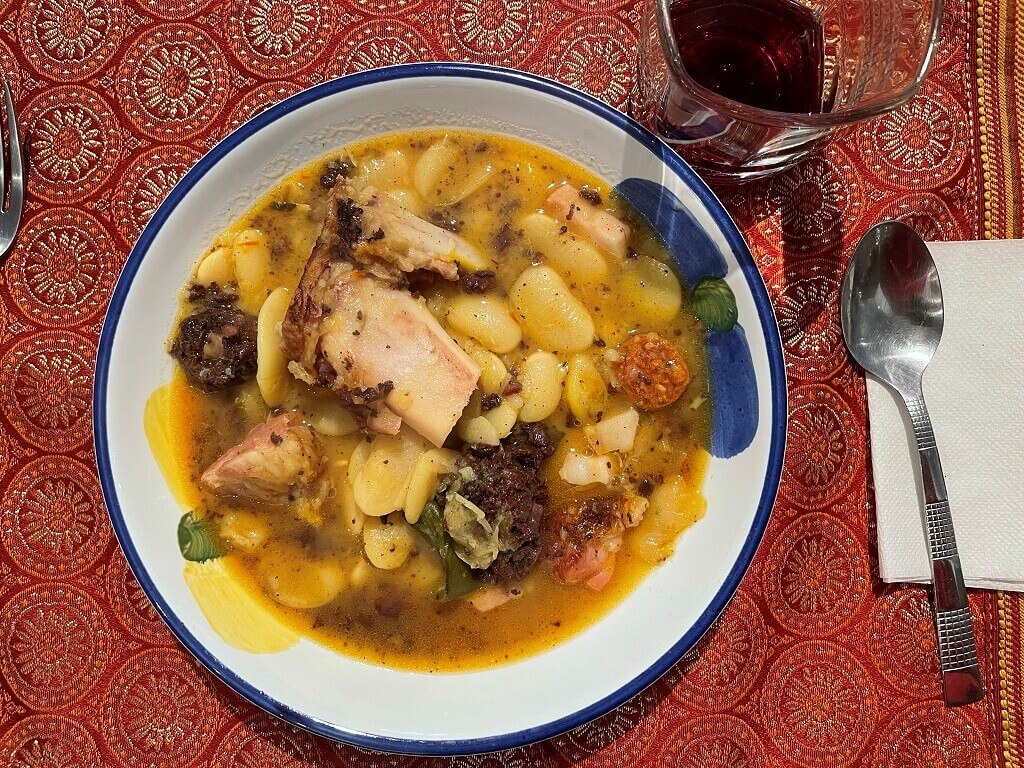
XUIXO FROM GIRONA
Girona is a charming medieval town located just outside of Barcelona in Catalonia, Spain.
A day trip to Girona from Barcelona is an essential experience for anyone who loves history and authentic cuisine.
As you stroll through the narrow, cobblestone streets of Girona you’ll notice bakery after bakery with distinct stuffed pastries in their windows.
Known as xuixo, these are Girona’s most famous export (after Game of Thrones filming locations).
Sort of a cross between a croissant and a cannolo, xuixo is a cream-filled pastry that is deep-fried and sprinkled with sugar.
The cream filling could be traditional creme catalan, or it could be inspired by the baker’s whims that day in flavors like chocolate, lemon, cinnamon or strawberry.
The pastry is so iconic in Girona that the region organizes an annual “Xuixo Procession” each autumn, where local families stroll through town sampling various xuixos that are donated by bakeries in exchange for donations to non-profit organizations.
Although many travelers visit Girona for the day, if you really want to sample all of the culinary delights of this Catalan town you’ll need to stay overnight.
After all, Girona is home to eight Michelin-recommended restaurants (including one with the highest possible recommendation – three Michelin stars!).
Girona is beautifully representative of the varied regional cuisine of Spain.
For overnight visits, the quaint Hotel Historic is ideally located in the heart of the Old Town.
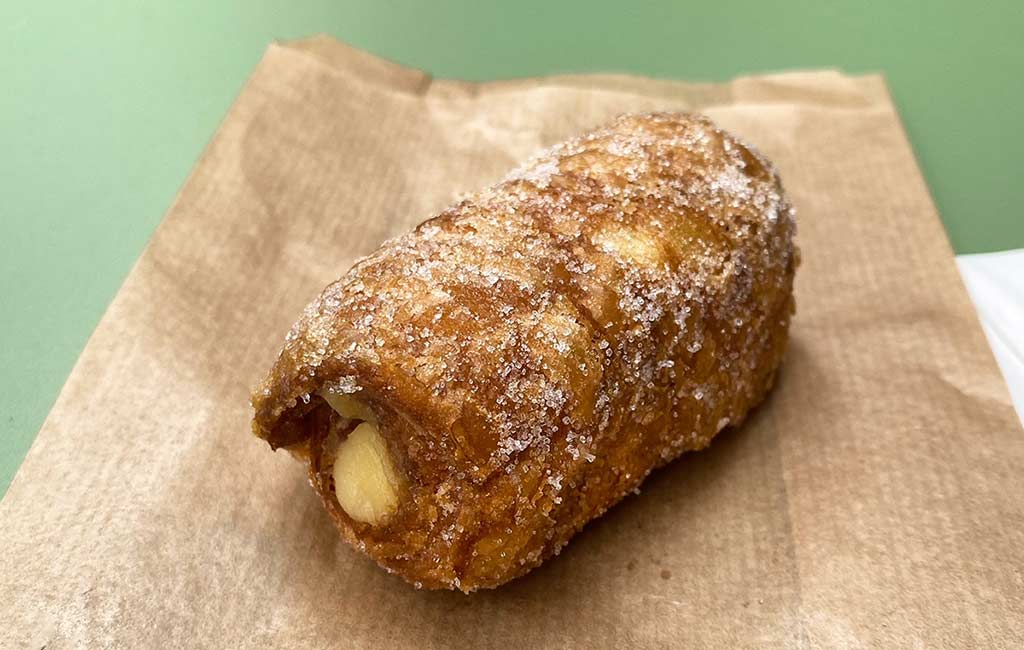
TARTA DE SANTIAGO FROM SANTIAGO DE COMPOSTELA
The Galician dessert from Santiago de Compostela, Tarta de Santiago (Santiago Cake/St. James Almond Cake) is a delicious cake that has been made over many years.
Its exact date is still questioned, but there are records show that it was baked even as far back as 1577. The recipe had different names before it was officially known as the Torta de Santiago (Santiago Cake).
It was called the “Torta Real” (Royal Cake) or “Bizcocho de Almendra” (Almond Cake).
There are legends that say that the cake was made as a gift for the noble pilgrims that followed the Way of St James and reached the spiritual medieval city of Santiago de Compostela.
This traditional sweet from the North-Western part of Spain consists of sugar, eggs, almond meal/flour, and optionally a bit of Galician Aguardiente Liqueur, lemon zest, or even a bit of cinnamon spice.
A dessert that was considered a luxury to eat back in the day, it was given to the pilgrims after they completed their Camino de Santiago walk to replenish their energy.
The Torta is typically in a round shape. The top of the cake is covered with sugared icing with the stencil shape of the cross of Santiago, which gives the cake authenticity.
It has a unique golden color, almond flavor, and a quite moist and spongy texture, resulting in a treat for the palate.
An old Galician traditional dessert, typical of the regional cuisine of Spain, that you should try when visiting the marvelous city of the pilgrims, Santiago de Compostela!
A charming place to stay in Santiago is in a former convent. The Hotel Palacio del Carmen is part of the Autograph Collection and close to all the city’s attractions.

BOCADILLO DE CALAMARES FROM MADRID
Bocadillo de Calamares, also known as squid sandwich, is a food specialty popular in Spain and representative of the regional cuisine of Spain.
Originated in Madrid, this dish contains squid mixed in the batter of flour. The batter is fried in olive oil or other oils and served with a spicy tomato sauce and mayonnaise. The dish is served quite similarly to patatas bravas.
It is usually eaten freshly made and hot and is a delightful example of regional cuisine of Spain.
The travelers will find this food in every street of Madrid and it is a must-try for the first comers.
It is a typical Madrid food, which is fresh rolled bread filled with squid rings. Coated with flour and deep-fried, this crunchy dish makes your mouth water.
People in Madrid usually gulp their crunchy Bocadillo de Calamares with fresh beer or a caña. It is fine to have it for breakfast, lunch, snacks, or dinner.
The best part is, this dish is available at street restaurants in Madrid. You can find the best ones at Bar La Campana at around 3 USD only.
The travelers visiting Madrid for a complete tour may enjoy a stay at Leonardo Hotel Madrid City Center. They may also find the town’s favorite dish at nearby restaurants from the hotel.
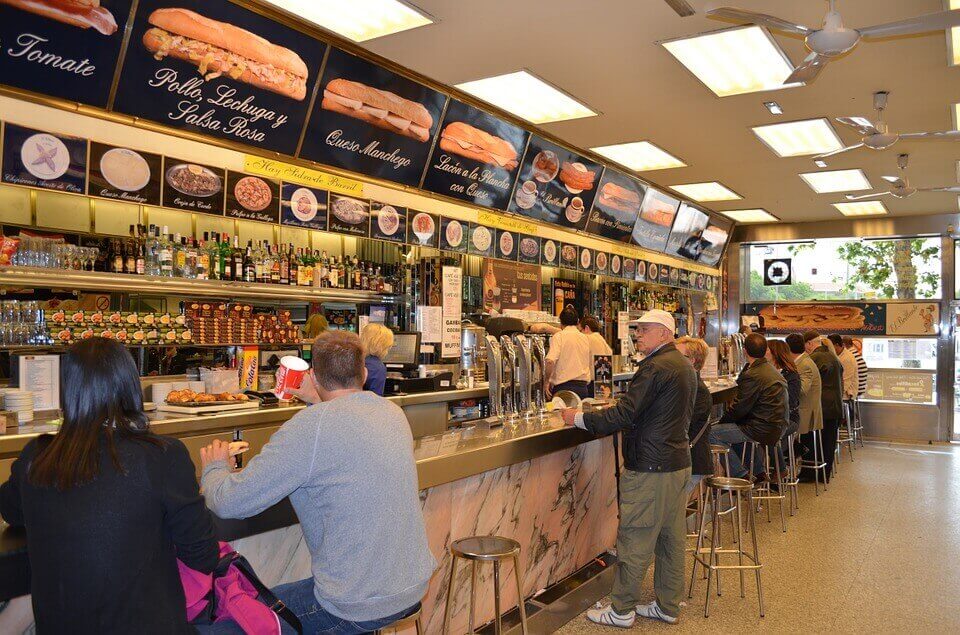
SUCKLING PIG FROM SEGOVIA
Segovia is a UNESCO World Heritage city in the Castile and Leon region of northern Spain – an easy day trip from Madrid.
This historic city is most famous for the Roman Aqueduct and the magnificent Alcazar.
But did you know Segovia also has a regional Spanish dish to its claim to fame? It is the perfect example of the regional cuisine of Spain.
This mouth-watering dish is called cochinillo asado, which is also known as suckling pig. suckling pigs are baby pigs – not older than three weeks.
They are cooked in a special oven for several hours. And the result is magic! The outer skin is pretty crispy, but the meat inside is so tender that it can be cut using a plate.
There are a number of restaurants that serve delicious suckling pigs in Segovia. Casa Duque, a short walk from the Roman Aqueduct, is one of them.
Founded in 1895, this family-run restaurant is the oldest one in Segovia, feeding sucking pigs to happy customers for over 125 years.
Restaurants Meson De Candido and Restaurante José María are also highly recommended places to try out this delicious dish.
Hotel Don Felipe at the heart of the historic town centre is a great place to stay in Segovia.
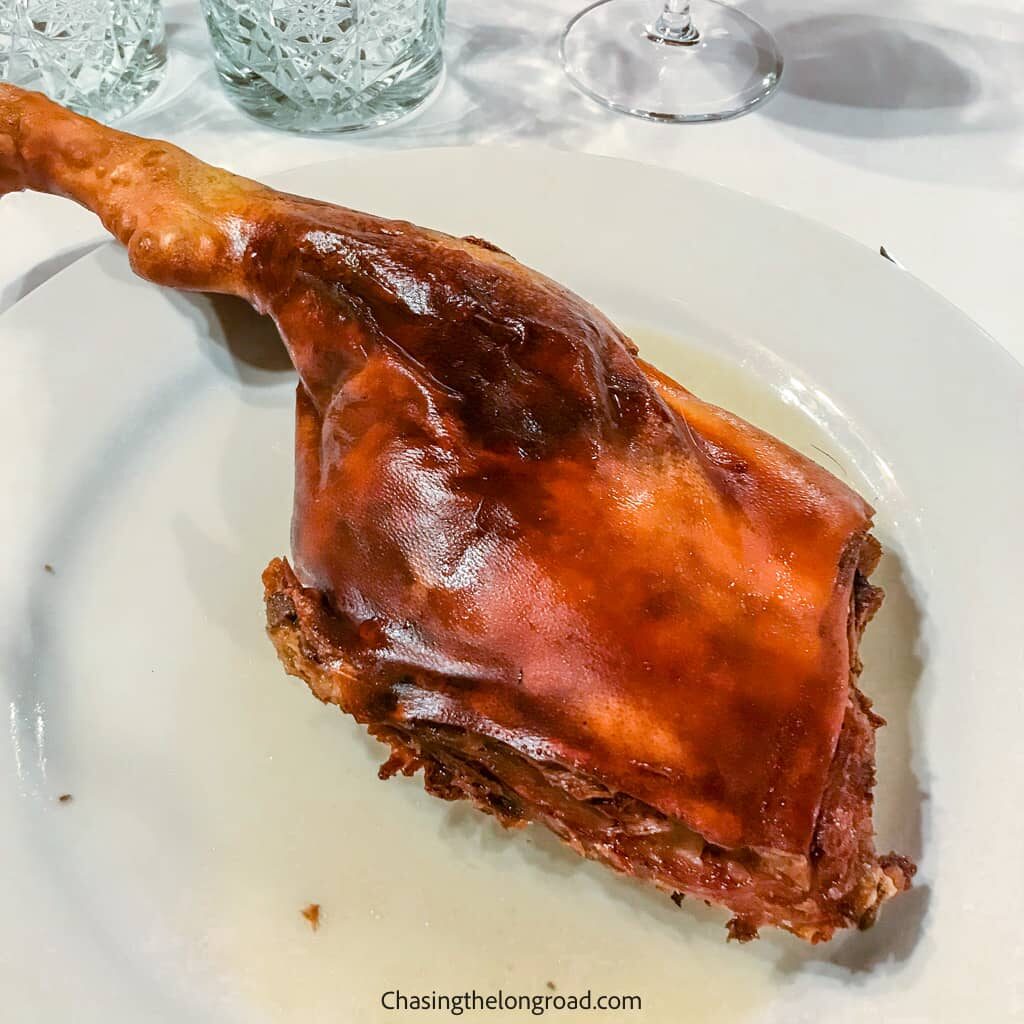
ESPINACAS CON GARBANZOS FROM SEVILLE
If you visit Seville, you will be sure to find espinacas con garbanzos on any tapas menu. This typical Spanish dish is a firm favorite.
While a simple dish, the combination of exotic spices, spinach and chickpeas offer a taste of Seville’s Moorish past.
The Moors brought these ingredients to Spain centuries ago and these flavors have become infused into the regional cuisine of Spain.
After the Moors left Seville, the chickpea stew remained popular with Spanish Catholics.
During Lent, when they couldn’t eat meat or fish, chickpeas provided a great source of protein and therefore became a traditional meal during this time.
Today, espinacas con garbanzos is enjoyed year-round, however, it is still closely associated with Easter.
Throughout Semana Santa it is a popular dish with locals and they will typically eat it at least a few times.
You will want to make time on your Seville itinerary to enjoy this delicious dish. Although it may not sound like much, the aromatic spices infused into the vegetarian tapa make it surprisingly tasty!
Consider staying at Meliá Seville for a perfect, central location, surrounded by excellent tapas restaurants!
Better still, after you’ve enjoyed a full lunch and sangria, you can relax at the hotel’s rooftop pool overlooking Plaza de España!
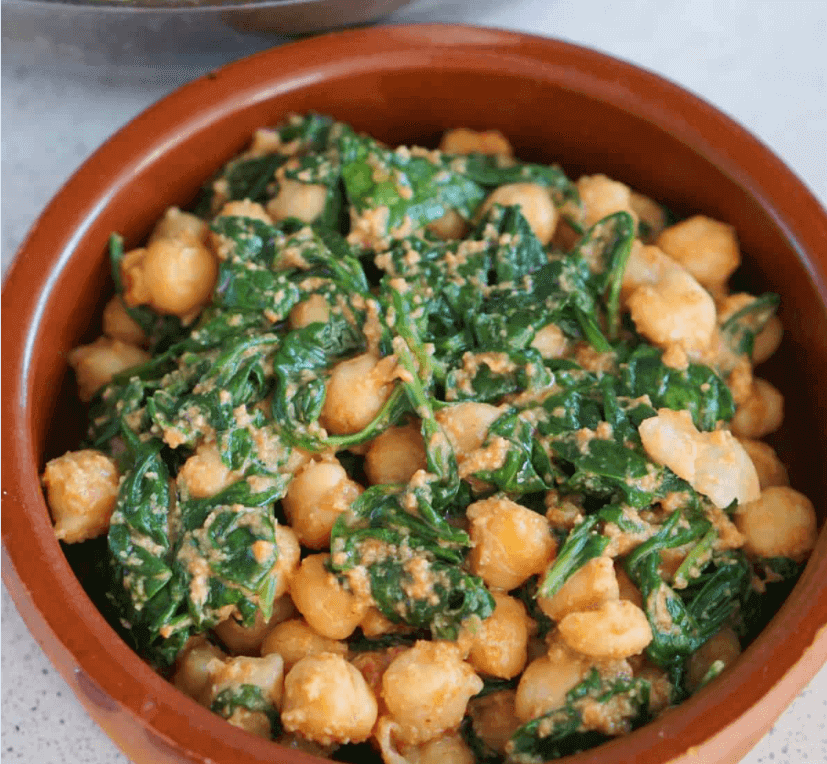
CALCOTS FROM CATALONIA
If there’s one thing that nearly all Catalans look forward to every year, it’s definitely calçots season.
Because every spring between December and March, this delicious Catalan dish ends up on the grill everywhere in the region.
Calçots are a type of spring onion. It is roasted on the grill and then served with a typical sauce. This sauce is called romesco and is made from dried fruits, nuts, and vegetables.
Since the outer layer of the calçots is black and burned by grilling, you have to peel it off first before eating the delicious inside.
It’s best to put on some gloves to do this. Otherwise, your hands will turn completely black. But don’t worry, usually, the gloves are served right along with the meal.
In most restaurants, the calçots are served together in a menu that includes various meats and other grilled typical Spanish vegetables such as peppers and eggplant.
The typical Crema Catalana usually accompanies the menu as a dessert.
Calçots are not only incredibly delicious but also have a long tradition in the region.
As a result, during calçots season, Spaniards from all over the country travel to Catalonia to enjoy this delicious dish.
If you’re traveling to Spain in the spring, make sure not to miss out on this delicious regional cuisine of Spain, an authentic calçotada.
If Barcelona is your base for exploring Catalonia, stay at the Casa Fuster, an architectural masterpiece.
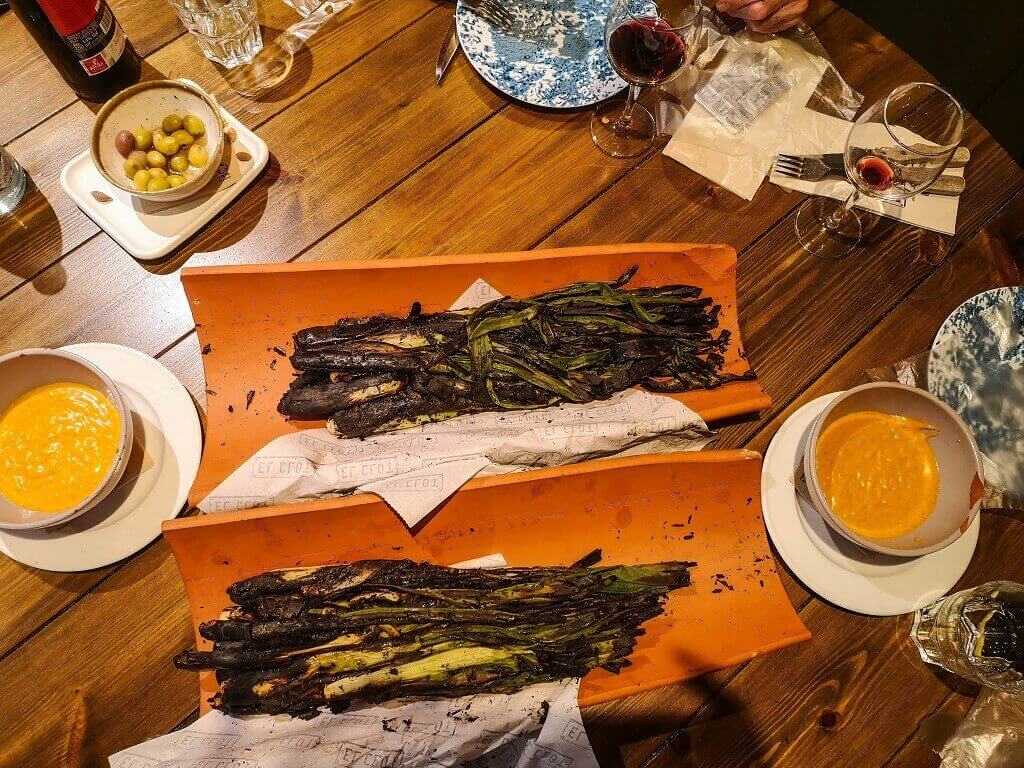
BACALAO PIL-PIL FROM BILBAO
Bacalao al pil pil is one of the most famous dishes of Basque Country and a specialty in the city of Bilbao.
Made only of four ingredients (cod fish, olive oil, chili peppers and garlic), this delicious dish is cooked in a particular way which brings out the gelatin in the fish to make a thick sauce and served topped with the seasoned oil in which it was cooked. No waste here!
The sauce (Pil Pil) is made by carefully swirling the whole pot (with the fish inside) until the jellys escapes and little by little, mix with the seasoned oil to create the sauce.
The name Pil Pil comes from the sound that can be heard when the fish and oil is swirled in the pot.
Bacalao pil-pil is traditionally an Easter dish as this is the time of year when cod is fished, however, nowadays the cod is preserved in salt so you can enjoy the dish all year round.
If you really want to experience the sacristy around this delicious food, visit Bilbao during the celebration of Aste Nagusia at the end of August.
During this festival, there is a competition to award the best cod al pil pil.
Make sure to book your hotel in Bilbao well in advance though as everyone wants a chance to taste the best of the best foods! I recommend NYX Hotel for an elegant stay in a great location.
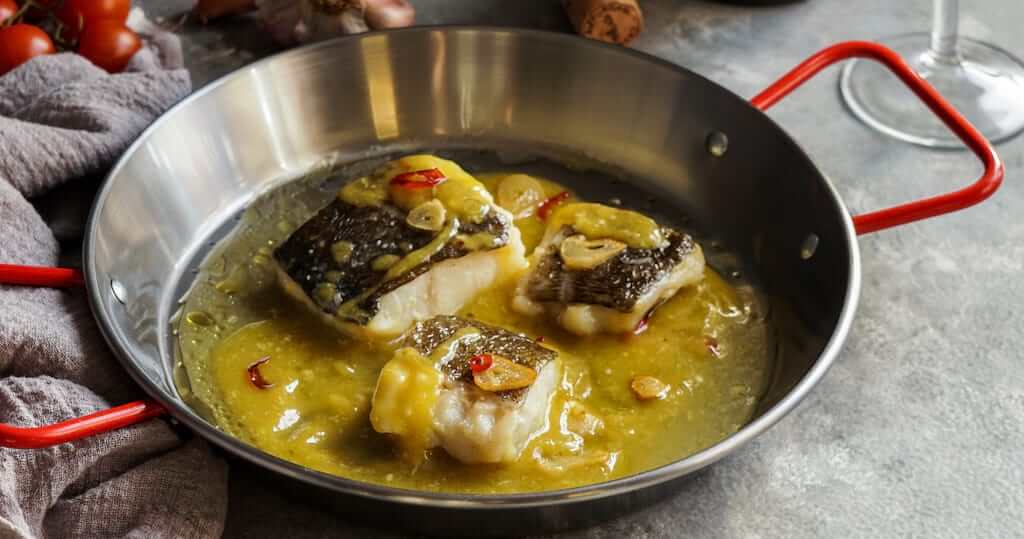
PULPO A LA GALLEGA FROM GALICIA
Perhaps one of the most iconic regional cuisines of Spain, Pulpo a Feira or Pulpo a la Gallega is a traditional Galician dish that one can try at many restaurants throughout the region.
Galicia, in northern Spain, is famous for its fresh seafood and fish. The main ingredient of the dish is pulpo which means “octopus” in Spanish.
Despite its name, the dish did not originate in Galicia but in the inland province of Extremadura.
So-called Maragato people traded paprika and olive oil for dried octopus from Galicia.
The dish is quite simple and consists of very few ingredients; octopus, olive oil, and spices.
The key secret to preparing a good pulpo is timing, it can’t be overcooked otherwise it gets tough. First, octopus tentacles are boiled in a copper pot for 30-40 minutes.
Then, it’s left in the pot for another 15 minutes away from the fire. After that tentacles are cut into pieces, seasoned with olive oil, salt, and paprika.
Pulpo a la Gallega is usually served with white bread and young red wines.
Eating Pulpo a la Gallega with a glass of local wine is a not-to-miss thing in Santiago de Compostela.
Best places to stay in Santiago de Compostela include Hostal Reis Catolicos and Hospedería San Martín Pinario.
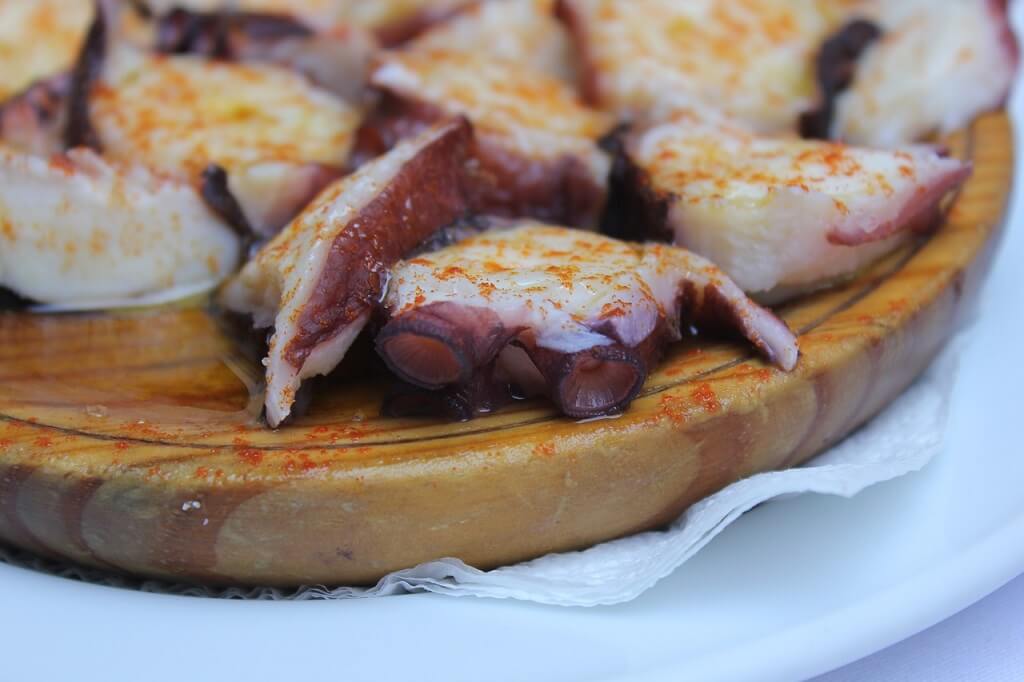
PINXTOS FROM THE BASQUE REGION
Traditionally found in the northern regions of Spain, pintxos are delicious bites that can be eaten as a snack while in a bar with friends or enjoyed as a meal.
They can sometimes be confused with tapas as the toppings are often the same, but the key part of any pintxo is a small slice of bread, topped with meat, fish, a vegetable or even a piece of tortilla, then secured with a toothpick.
This toothpick is what gives the dish its name, as pincho means spike in Spanish, and pintxo is the Basque name.
Many bars in the north of Spain, like in Bilbao, will have trays of different pintxos along the top of the bar. You’ll also see this further afield as pintxos gain popularity.
As you enjoy a drink or two in the bar, you can sample as many as you like, collecting the toothpicks as you finish.
Once you’ve had your fill, you present your toothpicks to the bar staff and they charge you accordingly, usually no more than a couple of euros per pintxo.
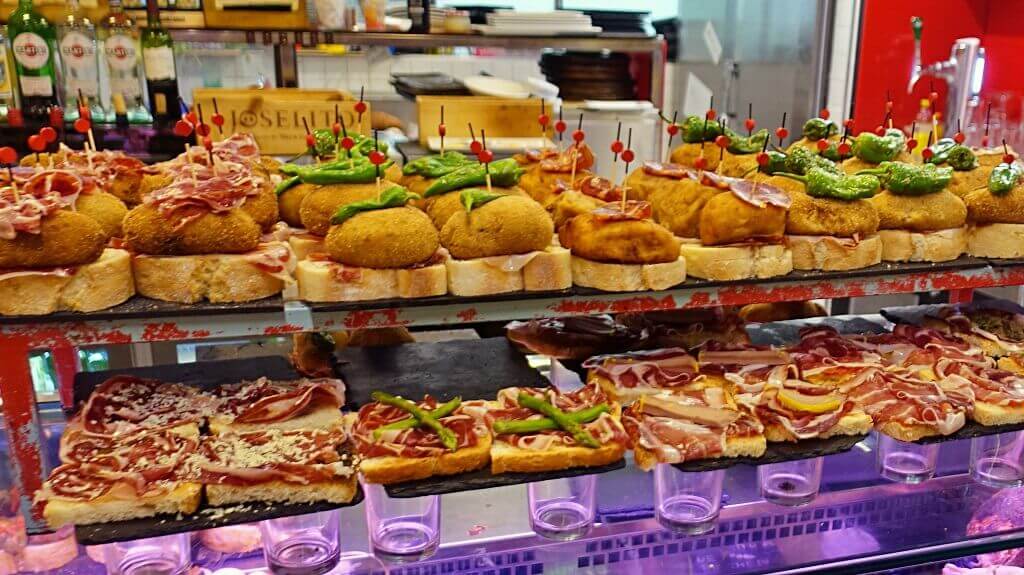
CHURROS CON CHOCOLATE FROM MADRID
Churros are a delicious fried treat and Madrid is one of the best places to try them.
They’re best eaten with hot chocolate sauce that takes on a sort of pudding consistency. It usually comes in a sizable bowl from which you can drink the leftovers after you’ve finished dipping all your delicious churros.
Madrid has an incredible selection of churrerias and cafes where you can try churros of all different sizes.
Mini churros are the perfect portable snack you can take with you as you stroll through the streets of Madrid.
The Churrería Madrid 1883 is one of the best places to try your first churros in Spain’s capital. It’s located in the popular area of Malasaña where you’ll find interesting restaurants, cafes and thrift shops.
After a long day of shopping, it’s a fantastic place to have a break with a hot drink and a plate of fresh churros. They’re always made to order and never stored.
This makes them especially delicious and authentic. Never have churros somewhere where they’re already displayed in a window.
They’re meant to be made fresh and won’t taste right if they don’t.
If you’re looking for a great luxurious hotel in Madrid that won’t break the bank, the Emperador Hotel and its incredible rooftop, are a great choice.
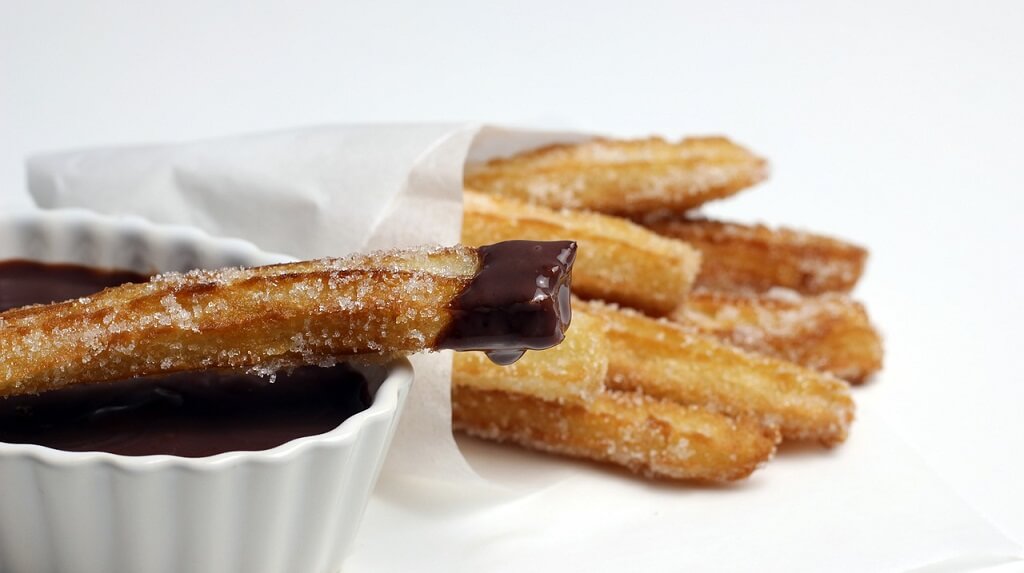
PAELLA FROM VALENCIA
Perhaps the very definition of Spanish food, the quintessential Spanish region dish, no list of regional cuisine of Spain can be complete without mentioning the Paella Valenciana.
On a trip to Valencia, you have to try a traditional Valencian paella.
Paella is a filling rice dish cooked in a wide, shallow metal pan and flavoured with vegetables, fish, seafood, rabbit or chicken.
It was originally peasant food and would be eaten with everyone all together, each person digging into the large pan with their own wooden spoon.
On special occasions a little saffron might be added to give the paella extra colour and flavour.
While you can enjoy paella all over Spain, Valencia is the undisputed home of the dish.
Everything in a Valencian paella is thoroughly local, from the rice that’s been grown in the area for over 1000 years to the fish and seafood that is landed at Valencia’s port.
Paella is actually the name for the pan in which the dish is made rather than the dish itself.
You can buy your own paella pan at Valencia’s Mercado Central, where you’ll see them hanging in all sizes across the tops of stalls like bunting.
There are lots of gorgeous places in Valencia to enjoy authentic paella with a view.
The bars and restaurants around the central Plaça de la Reina are great for people watching. The Hotel One Shot Colon 46 is convenient for all the major sights in Valencia.
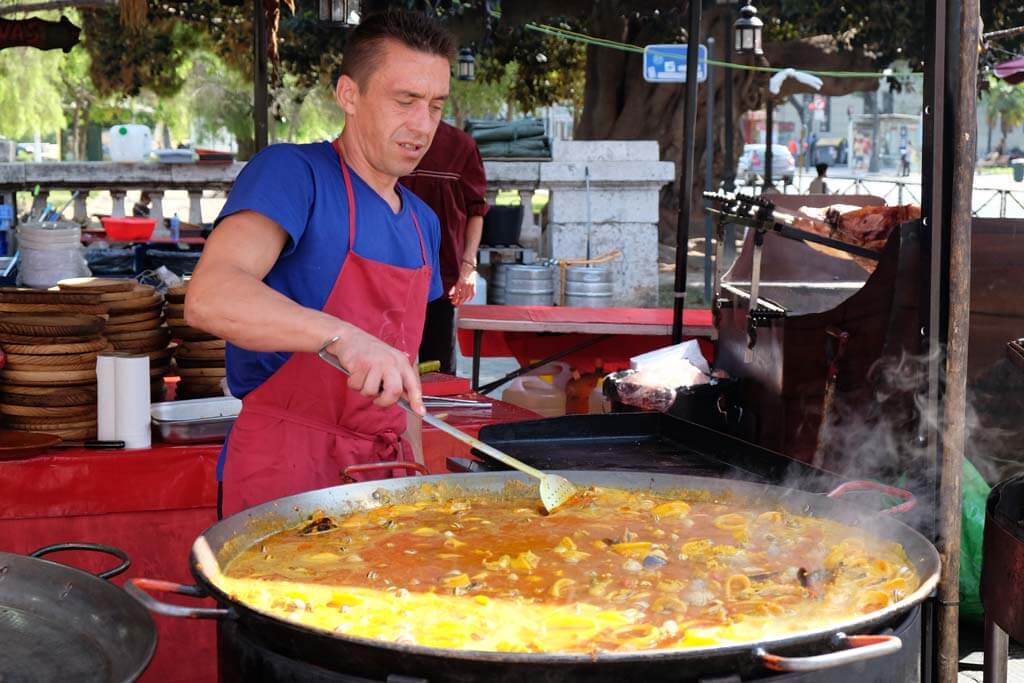
GAZPACHO FROM ANDALUCIA
Gazpacho is a delicious cold soup that originated in the southern region of Spain.
There are many theories to its roots. As Andalusia is a region with Moorish influences, it’s said that the word “gazpacho” derives from Arabic ‘Al-Zabat’ meaning ‘to crush’ or ‘to bruise’.
This refers to the crushing or bruising of the vegetables to prepare the soup. Nowadays, all you do is throw all the ingredients together in a blender!
This summer delight is made of fresh ingredients like cucumbers, tomatoes, bell peppers, garlic, onions, and olive oil.
Sometimes, red wine vinegar is also added for extra flavor. Its texture can range from watery to chunky to thick. Breadcrumbs can be added to give it more body.
Traditionally, it’s served in a glass or bowl and is garnished with diced bread, croutons, or cubed vegetables.
Gazpacho is most commonly eaten during the sweltering Spanish summer months, typically as an appetizer. It’s served either chilled or at room temperature.
A beautiful, traditional hotel in Andalusia is the Hotel Alfonso XIII in Seville. It’s a luxury accommodation in the heart of the city, and Spanish royalty is known to stay here during their visits.
Its ornate decor and enchanting courtyard is the perfect setting for a quintessential Sevillano experience.
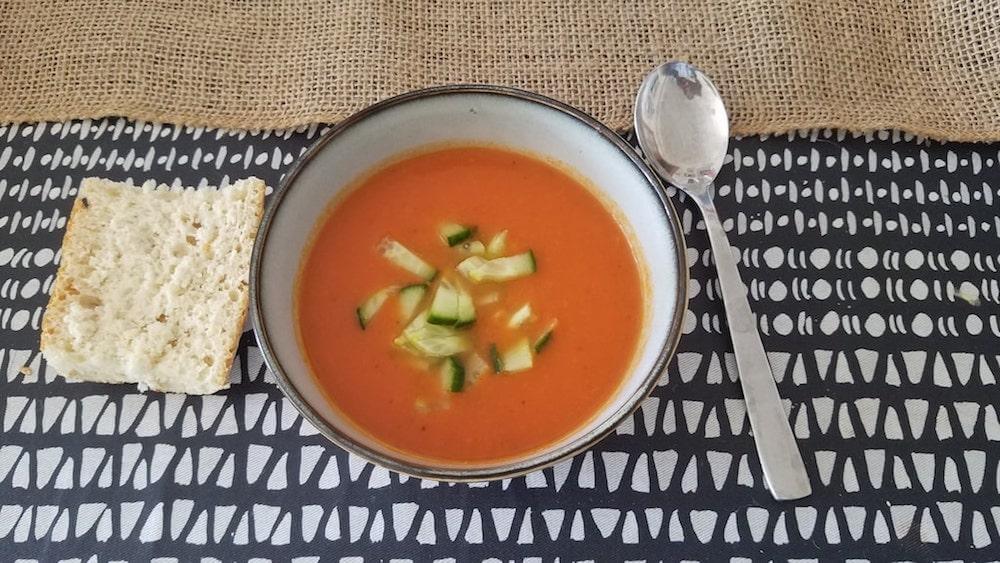
BURNT BASQUE CHEESECAKE FROM SAN SEBASTIAN
A modern dessert, burnt Basque cheesecake originated in the city of San Sebastián in Basque Country in Northern Spain.
The simple yet delicious cake first appeared at La Viña, a restaurant in San Sebastián’s old town, in 1990, a creation of chef Santiago Rivera.
Basque cheesecake uses a few high-quality ingredients and, what makes it unique is the toasted, caramelised layer on the top, giving it a burnt appearance.
Now popular around the world, there are variations on the traditional Basque cheesecake recipe, with added flavours to the recipe including lemon, chocolate and even blue cheese.
While you can sample Basque cheesecake in restaurants around the world, there’s something extra special about enjoying a slice at the restaurant where it was first made.
La Viña still serves the dessert, along with a selection of pinxtos and regional wines, and visiting makes a lovely addition to a trip to San Sebastián.
There’s a good range of food in San Sebastián including local dishes and fine dining options.
Stay in Lasala Plaza Hotel while you’re there, for a central location with beautiful views of the water.
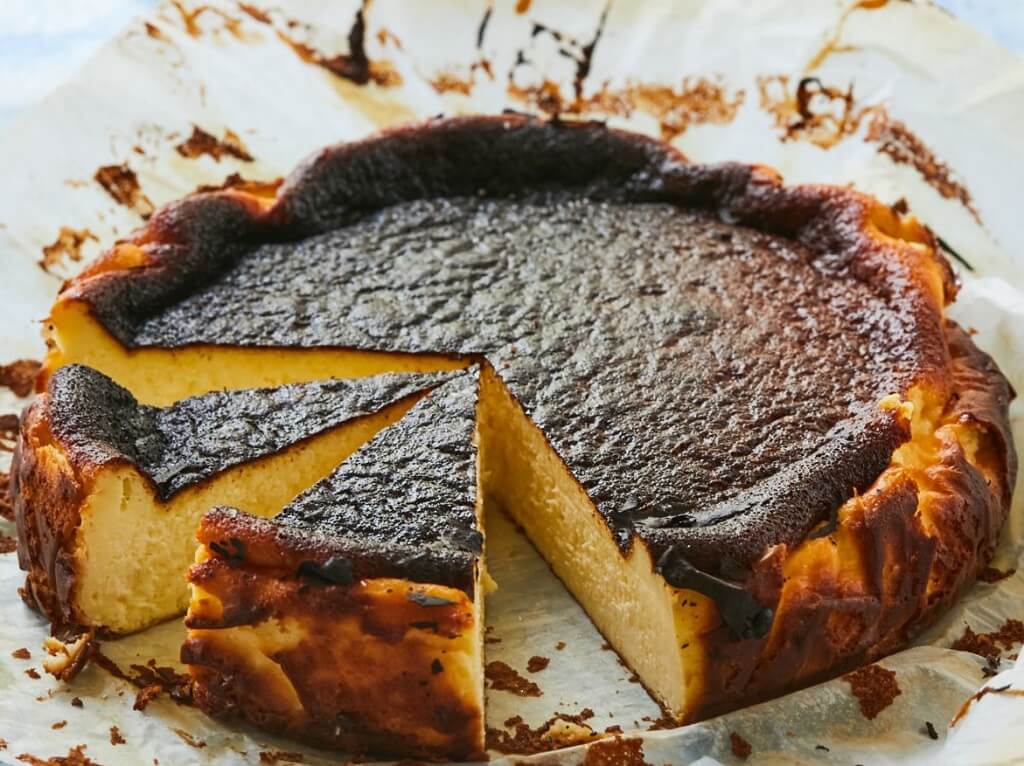
What are your thoughts on the regional cuisine of Spain? What are your favorite Spanish dishes? Did we miss any? Let us know in the comments.
Don’t leave home without a couple of good reference books so you are prepared with key information before you arrive.
Here are some useful guidebooks and Spanish food accessories and seasonings for you to experiment with.

BTW, if you are getting ready for your trip, make sure to take advantage of these useful, money-saving links to book your trip:
- Research and book your flight with Skyscanner. I have found them to be the best because they list all airlines including the budget ones. You are always sure of having researched all options.
- For car rental around the world, Discover Cars has flexible pickup and drop-off options, I recommend Discover Cars.
- Book your accommodation with Booking.com. I find they have a wide selection and a nice, user-friendly, transparent website.
- Protect your trip and, more importantly, protect yourself with travel insurance. I use Travelinsurance.com and have been very happy with them.
- Looking for a small group tour to unforgettable destinations with top professionals? Intrepid Travel is your choice.
- For more general tours to any destination or attraction, book with Viator. Check them out.
- Need a visa? Get your visa for all countries with Passport Visa Express.
- Looking for a cool walking tour to explore a city? My favorite walking tours are offered by Take Walks.
- Food and drink tours are the best way to enjoy a city. And Devour Tours are my favorite.
- Looking for a good VPN to protect your security, privacy and freedom online while traveling? Nordvpn is your best option.
- The best and most economical way to stay connected while traveling is with an Airalo eSIM.
I personally use, and can recommend, all the companies listed here and elsewhere on my blog. By booking through these sites, the small commission we earn – at no cost to you – helps us maintain this site so we can continue to offer our readers valuable travel tips and advice.




















4 Responses
For us, one of the joys of travelling is trying new food & regional specialities. Paella originates in the Valencia region, so when we were there last October we decided to a Paella making experience. We spent a fun half day with a paella master learning the secrets of authentic Paella Valenciana.
Now we’re hooked and look to do at least one cooking experience in each city we visit. Recently in Barcelona we did two. It’s so much fun, and you get to meet some really fab people.
Glad you liked the post. Yes, I always try to include a cooking lesson experience wherever I go.
would this trip be offer in 2023?
Thank you for reaching out, Josefina. If you are referring to the northern Spain food and culture tour, yes, we anticipate that it will be offered in 2023.